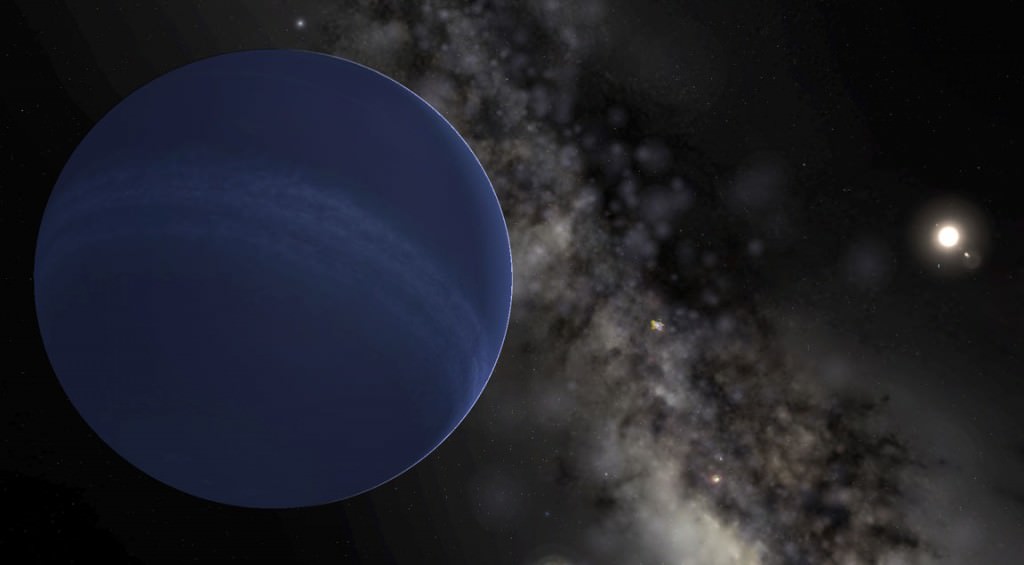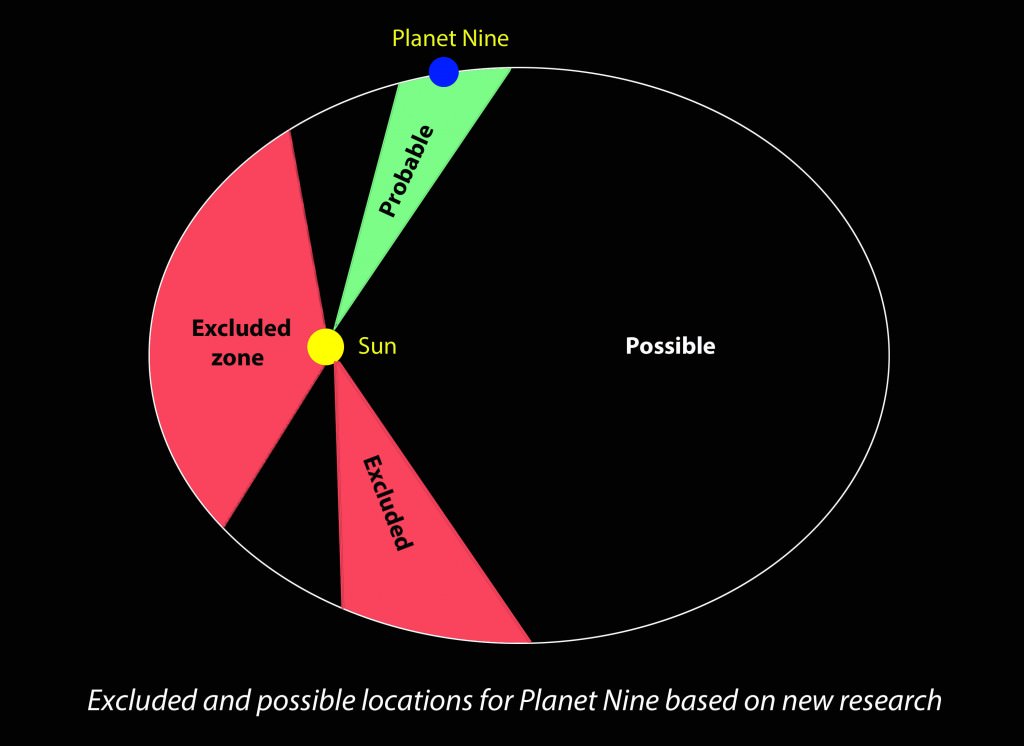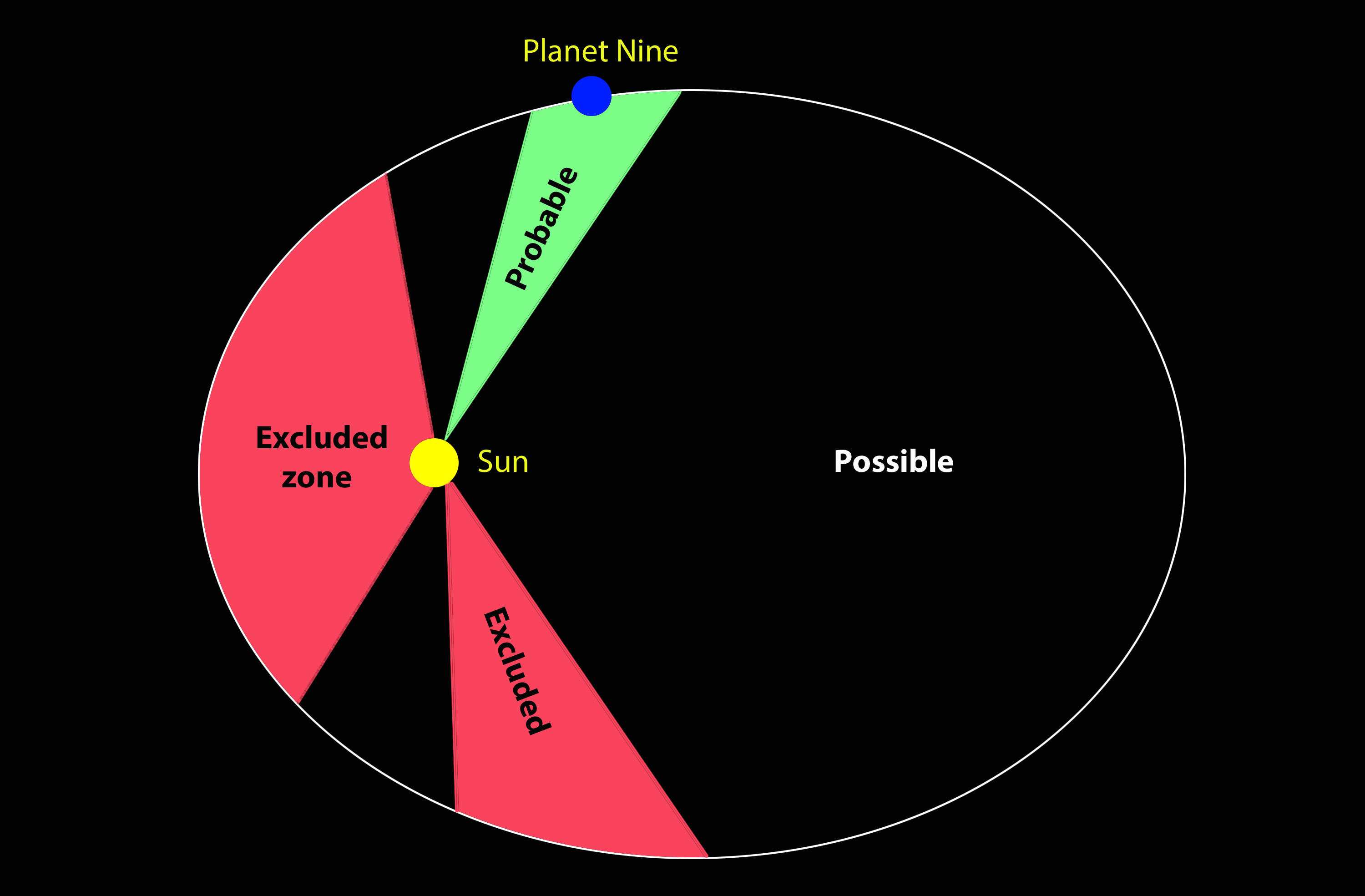
Last month, planetary scientists Mike Brown and Konstantin Batygin of the California Institute of Technology found evidence of a giant planet tracing a bizarre, highly elongated orbit in the outer Solar System. Nicknamed Planet Nine, it’s estimated to be 10 times more massive than Earth with a diameter as large as 16,000 miles (25,750 km). The putative planet orbits about 20 times farther from the Sun on average than Neptune or some 56 billion miles away; at that tremendous distance it would take between 10,000 and 20,000 years to complete one orbit around the Sun.
![The six most distant known objects in the solar system with orbits exclusively beyond Neptune (magenta) all mysteriously line up in a single direction. Also, when viewed in three dimensions, they tilt nearly identically away from the plane of the solar system. Batygin and Brown show that a planet with 10 times the mass of the earth in a distant eccentric orbit anti-aligned with the other six objects (orange) is required to maintain this configuration. Credit: Caltech/R. Hurt (IPAC); [Diagram created using WorldWide Telescope.]](https://www.universetoday.com/wp-content/uploads/2016/01/Planet-nine-1024x576.jpg)
All well and good. But with such an enormous orbit, astronomers face the daunting task of searching vast swaths of space for this needle in a haystack. Where to begin? A study done by a team of French scientists may help narrow the search. In a recent paper appearing in Astronomy and Astrophysics, astronomer Agnes Fienga and colleagues looked at what effect a large Kuiper Belt planet would have on the orbits of other planets in the Solar System, focusing their study on Saturn. Thanks to NASA’s Cassini orbiter, which has been orbiting Saturn since 2004, we can precisely calculate Saturn’s position along its orbit.

Based on the planet’s “residuals”, the difference between the calculated position of Saturn versus what was actually observed, the team was able to exclude two sections of its potential orbit and home in on “probable” swath and a much larger “possible” section of the orbit. The process may sound familiar, since it was the one used to discover another planet more than 150 years ago — Neptune. Back then, irregularities (residuals) in the motion of Uranus led astronomers in 1847 to predict a more distant 8th planet as the cause. On September 24, 1846, Johann Galle discovered Neptune only 1° from its position predicted by French mathematician Urbain LeVerrier.
While the current solution for Planet Nine doesn’t come anywhere near as close, it’s a step in the right direction.


Which I gather might be to the right of Orion, near about northern Eridanus?
See http://www.jasonhigley.com/_/rsrc/1455517013878/home/planet-9-information/TychoSkyMap-WITH-LAYERS-AfterMerge-25PCT-REDUX-ByJasonHigley.jpg
Thanks to so called Modern Science’s ignorance of ancient wisdom this MS is discovering what was known in ancient times (before 9500B.C.) only now. They are looking for Planet X where actually (more distant) planet XI-Nemesis is. This place is depicted on ancient astronom. maps. Even Milagro cosmic rays survay had discovered during 7years of its working time position of XI,..cca where Aldebaran is.
http://senmut.webs.com/orioncarpetandmilagro.JPG
They can make computations, simulations,…but X and XI with their orbits, mases were known to advanced vanished civilisations. Those civilisations were destroyed before half of precession cycle, when X in extreme perihelia, during XI (probably aphelia) caused global flood. Those ancient advanced people knew about forthcoming catastrophe and sent messages in form of texts, astronomical maps to warn us. We can like idiots ignore those warnings or devote them prooper time and effort.,..Pavel Smutny
a global flood ? where did all that water go?
Simply because A planet like that was predicted in ancient times (actually there have been several that fit that bill) doesn’t mean that THIS one is the SAME one… Learn to rationalize, friend.
If these ancients were so advanced that they could see dim planets in the outer Solar System, and predict an oncoming catastrophe, why couldn’t they protect their civilization against this disaster?
When that PX is much more masive than Earth,….so it is not easy ti divert such planet. It is possible to destroy it,..but fragments from it could surely totaly destroy life on Earth,..
“and sent messages in form of texts”
I can assure you, I’ve never received any of these text messages! Believe me, if I’d received an alerting text message from an ancient civilization, I would have heeded their warning! 😉
Please, look on part of my web: http://senmut.beep.com/narmeratlanteantech.htm over there are those messages in form astronom. maps wowen into,..
Water was sucked by gravit. force of X from south on north hemisphere. This is why even Ararat could been under waters,..
Thanks for this update Bob, This sure gets us all thinking again not just about Planet 9 but also about Earths past history.
I wonder how significant this result is. Could it have arisen just by chance? That is, if I put a fictitious planet at some arbitrary point in the outer Solar System and slightly fidget with the masses and positions of other Solar System bodies the way these authors have done, can I possibly get better residuals just by chance?
Put another way, these authors have added another free parameter to the system ie. the position of P9. Any time you add another free parameter to a model and refit it, you have a good chance of being able to improve the fit, whether the addition of the new parameter is properly motivated or not.
What they should do is run some more trials with P9 in locations *not* predicted by Brown and Batygin and see what happens. If there are many locations where the fits improve then that would point to this result being spurious. That’s what I suspect will happen.
They actually inferred the locale of P9 FROM the 6 bodies whose orbits they didn’t “fidget” with, but observed. Did you not read the same article that I just did? Don’t turn the equation backwards.
I’m talking about the article by Fienga et al linked in this UT post. What those authors did is put P9 at various points along the orbit proposed by Batygin & Brown then tweak the parameters of the big known Solar System bodies, slightly but within their uncertainties, to get the best fit for Saturn’s position. They got an improvement for a small segment of P9’s orbit and a deterioration for other parts. That work has nothing really to do with the orbits of the 6 KBOs that Batygin and Brown used to infer the existence of P9 to begin with.
The point I’m making is that adding a new variable parameter to any fitting scheme will usually allow you to get a better fit for some values of that new parameter, regardless of whether its addition is physically motivated or not. I suspect if Fienga et al had allowed P9’s position to be anywhere in the outer Solar System, not just on the orbit predicted by Batygin and Brown, that they would have found huge regions of space where the residuals improve. If so, that would be evidence that the position they’ve found is spurious.
Those simulations of Batygin, Brown, Lorio,… could help to find XI. But, they don’t know real mass of XI, they didn’t put to simul. X,…. so results could give us only aprox. right results. I made 12years ago many simul. with both (X, XI),….. Even R. Harrington knew in 1987,… that there are 2 grav. pulls,..and he gave cca good directions to them,…
I can’t wait for Planet XXX to arrive! I hear that’s where all of the hot chicks live!
I can’t wait for Planet X X X to arrive! I hear that’s where all of the hot chicks live!